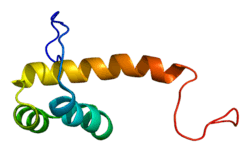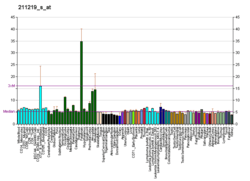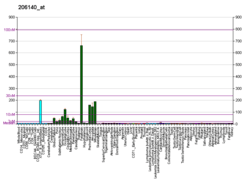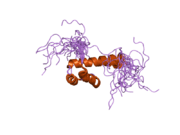LHX2
LIM/homeobox protein Lhx2 is a protein that in humans is encoded by the LHX2 gene.[5][6][7]
This gene encodes a protein belonging to a large protein family, members of which carry the LIM domain, a unique cysteine-rich zinc-binding domain. The encoded protein may function as a transcriptional regulator. The protein can recapitulate or rescue phenotypes in Drosophila caused by a related protein, suggesting conservation of function during evolution.[7]
Interactions
LHX2 has been shown to interact with CITED2.[8]
gollark: I rethought it and I think I might not support block-based HTML but allow a limited subset of inline HTML.
gollark: This is ridiculous. The HTML standard is too complicated and has too many weird edge cases. I'll just make my markdown thing ignore HTML or treat it as normal text.
gollark: Why?
gollark: Well, you complain a lot about your country and money and stuff, which wouldn't really matter much to a world leader.
gollark: If you know an omniscient god, though, why are you not world leader?
References
- GRCh38: Ensembl release 89: ENSG00000106689 - Ensembl, May 2017
- GRCm38: Ensembl release 89: ENSMUSG00000000247 - Ensembl, May 2017
- "Human PubMed Reference:". National Center for Biotechnology Information, U.S. National Library of Medicine.
- "Mouse PubMed Reference:". National Center for Biotechnology Information, U.S. National Library of Medicine.
- Wu HK, Heng HH, Siderovski DP, Dong WF, Okuno Y, Shi XM, Tsui LC, Minden MD (July 1996). "Identification of a human LIM-Hox gene, hLH-2, aberrantly expressed in chronic myelogenous leukaemia and located on 9q33-34.1". Oncogene. 12 (6): 1205–1212. PMID 8649822.
- Rincon-Limas DE, Lu CH, Canal I, Calleja M, Rodriguez-Esteban C, Izpisua-Belmonte JC, Botas J (April 1999). "Conservation of the expression and function of apterous orthologs in Drosophila and mammals". Proc Natl Acad Sci U S A. 96 (5): 2165–2170. Bibcode:1999PNAS...96.2165R. doi:10.1073/pnas.96.5.2165. PMC 26754. PMID 10051612.
- "Entrez Gene: LHX2 LIM homeobox 2".
- Glenn, D J; Maurer R A (December 1999). "MRG1 binds to the LIM domain of Lhx2 and may function as a coactivator to stimulate glycoprotein hormone alpha-subunit gene expression". J. Biol. Chem. UNITED STATES. 274 (51): 36159–36167. doi:10.1074/jbc.274.51.36159. ISSN 0021-9258. PMID 10593900.
Further reading
- Gerhard DS, Wagner L, Feingold EA, et al. (2004). "The status, quality, and expansion of the NIH full-length cDNA project: the Mammalian Gene Collection (MGC)". Genome Res. 14 (10B): 2121–2127. doi:10.1101/gr.2596504. PMC 528928. PMID 15489334.
- Ota T, Suzuki Y, Nishikawa T, et al. (2004). "Complete sequencing and characterization of 21,243 full-length human cDNAs". Nat. Genet. 36 (1): 40–45. doi:10.1038/ng1285. PMID 14702039.
- Strausberg RL, Feingold EA, Grouse LH, et al. (2003). "Generation and initial analysis of more than 15,000 full-length human and mouse cDNA sequences". Proc. Natl. Acad. Sci. U.S.A. 99 (26): 16899–16903. Bibcode:2002PNAS...9916899M. doi:10.1073/pnas.242603899. PMC 139241. PMID 12477932.
- Glenn DJ, Maurer RA (2000). "MRG1 binds to the LIM domain of Lhx2 and may function as a coactivator to stimulate glycoprotein hormone alpha-subunit gene expression". J. Biol. Chem. 274 (51): 36159–36167. doi:10.1074/jbc.274.51.36159. PMID 10593900.
- Bach I, Rodriguez-Esteban C, Carrière C, et al. (1999). "RLIM inhibits functional activity of LIM homeodomain transcription factors via recruitment of the histone deacetylase complex". Nat. Genet. 22 (4): 394–399. doi:10.1038/11970. PMID 10431247.
- Bendall AJ, Rincón-Limas DE, Botas J, Abate-Shen C (1998). "Protein complex formation between Msx1 and Lhx2 homeoproteins is incompatible with DNA binding activity". Differentiation. 63 (3): 151–157. doi:10.1046/j.1432-0436.1998.6330151.x. PMID 9697309.
This article is issued from Wikipedia. The text is licensed under Creative Commons - Attribution - Sharealike. Additional terms may apply for the media files.







